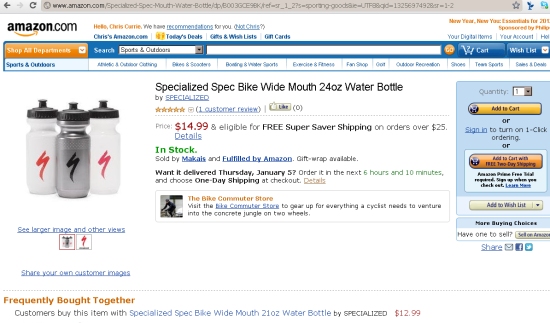Today was supposed to be all about e-commerce, but seems I picked a good week to criticize Specialized. By now, most of you have probably heard that they’ve chosen to sue Volagi, a new company that offers just one bike model, a disc brake road bike focused on big miles in less than ideal conditions. If you haven’t you can catch up with the basic announcement on Bicycle Retailer and Industry News, an interview with Robert Choi, founder of Volagi, on BikeRumor and a hell of a lot of praise for Volagi and venom for Specialized on Facebook.
So far, maybe at the peril of Volagi’s own legal defense, all the news of this has been coming from Volagi founders, Robert Choi and Barley Forsman, while Specialized remains silent, so it’s impossible to know if the big red S really was wronged by Volagi in any way, but one look at the Specialized Facebook page this morning tells us they’ve definitely wronged themselves. Yes, two things have become pretty clear from reading the information Volagi’s put out:
- Forsman and Choi, who used to work at Specialized but claim convincingly to have had absolutely no connection to performance bike designs or information and to have begun work on their own bike design only after they’d left the company, are either doing a pretty flamboyant job of lying to everyone, or Specialized has finally played the legal card one too many times to stifle competition.
- Regardless of the outcome, somebody in Marketing or PR at Specialized probably should’ve talked with someone in legal before letting this shitbomb go off, because the blowback of attacking a small and nearly defenseless company–and one that may turn out to be completely innocent–is currently not working out very well for Specialized.
Specialized’s own Facebook page suggests this lawsuit might not have been such a good move (word is they’re deleting negative posts, but, to their credit, I’ve not seen proof of that yet), but at least all this bully bullshit goes to illustrate a point today’s post was supposed to cover anyway. I’d planned to write today about how smaller companies can do battle with giants like Amazon, but Specialized has volunteered a glaring example of my first point.
Big Companies Suck at Social Media
Here are five things big companies need to do to fix their social media programs:
- Stop Pretending to Be People
I’m not sure why U.S. Senators and the corporations themselves keep getting so confused about this, but corporations are at their worst when trying to act like people. They tend to do much better when they acknowledge that they include people, and then letting those people communicate with customers–not as pieces of the corporation, but as themselves. Sure, it might not be such a good time to let Bob in Accounting talk about his collection of Nazi memorabilia in a video blog post, but usually there are people within your company who are involved in interesting things. The Specialized Win Counter, that keeps track of race victories, and stuff like the Trail Crew and news about their advocacy and charitable work are nice, but all of those things could belong to any company, which leads us to our second reason. - Let Us In
Yes, I know your Chinese-made carbon fiber has a special strand orientation that’s top secret and blah, blah, but seriously, we all know interesting shit goes on inside companies, and we’re clearly willing to watch even the most asinine of things related to businesses and what businesses do. The companies making the best use of social media are using it to tear down barriers between themselves and their customers. If you’re not willing to do that, it shows. - Stop Hiding Behind Mirrors
The “hang a mirror and hope for the best” strategy is used by many companies–you know, let us post pictures on your wall and that should keep us busy so you can get back to running your company. But so what. It’s nice to help establish and support a community of people who use your product, but a bunch of blurry pictures of Stumpjumpers isn’t doing much for anyone. I think people would be much more interested in seeing your bikes, trick advanced release shit we’re not supposed to know about taped over and all. Santa Cruz consistently gets this right. It’s fine to pretend it’s all about the customer, but we can tell when you’re just hiding behind that. - Talk About What Really Matters
This most recent lawsuit Specialized is pushing exemplifies everything that’s wrong with social media in the hands of big companies, and why it’s so important to small companies. The reason Volagi jumped out early with information about the lawsuit is that it’s all the owners could think about. You sued them, Specialized. You attacked everything they’d worked for, and that’s forced their lives to revolve around this situation, and they can’t help but share the experience–not because doing so is a good “business tactic,” but because it’s genuinely all they can think about right now. Hearing the founders tell that story is profoundly compelling in ways I don’t think Specialized could understand. If Specialized really was this pissed off to have been “wronged” by a company, why is it that a lawsuit is the first we hear of it? Why not an “Imitation Isn’t the Sincerest Form of Flattery” corporate stance, including video features of how Specialized does things differently, and why their designs have been copied? Maybe that exists, but in general, I never see honest content like this from larger companies with dedicated PR and social media staff. Only companies that let the stakeholders speak out are compelling to follow. In social media circles, this lawsuit by Specialized is playing out so horribly partially because it came out of nowhere–we don’t think of Mike Sinyard or anyone else at Specialized as having any design skills or intellectual property to guard, because they never talk to us about those things. When the first we hear about it as a lawsuit against a little company, their anger seems bloodless, disingenuous, making their attack just another sleazy and anti-competitive act of big attacking small. If there’s true passion and defense of intellectual property behind this action, why haven’t we heard about it from the company before? The fact that most carbon road frames look eerily similar and uninspired anyway doesn’t support Specialized’s contention that something was stolen from them. I always follow a simple rule: if the owner of the company can’t tell us why his stuff is better, it’s probably not. - Don’t be Assholes
No, seriously. If what you do for a living is prey off others and add nothing of quality to the world, you probably don’t want people following you anyway. I honestly think Specialized has done some really great things, but that only makes the events of this week all the more senseless. There should be a Specialized story to tell that’s bigger than the lawsuit attack on Volagi. The fact that there isn’t is what’s really causing the problem here. Volagi is currently winning the hearts and minds of consumers (even owners of Specialized bikes) right now partially because we all know they have a story to tell–they’ve created the first viable disc brake equipped road bike and potentially defined an entirely new category of bikes. In the eyes of the public, Specialized, a company with no story to tell, is attacking Volagi, a company that was in the middle of telling us all a pretty compelling one. In social media terms, butting in without having anything to say is the textbook definition of “asshole,” and, regardless of the legal outcome, Big Red lost this one.
Oh, and I also noticed nobody was using the “specializedbicycle” Blogspot any more, so I’ve taken over that location and posted a copy of this blog there as well. Good times.








